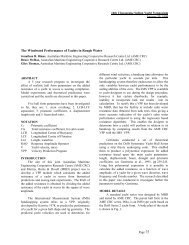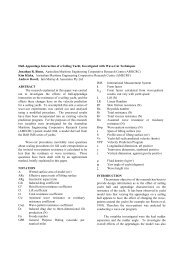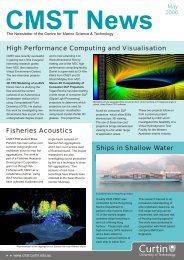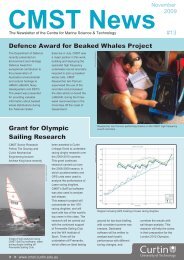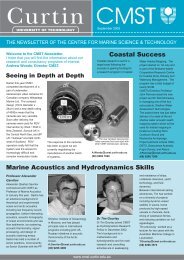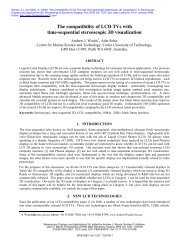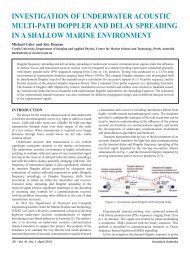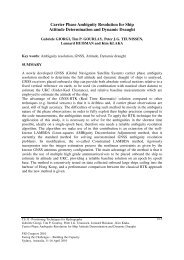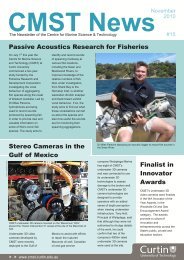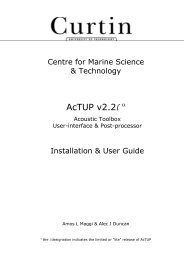Dynamic Stability of Ships in Waves - Centre for Marine Science and ...
Dynamic Stability of Ships in Waves - Centre for Marine Science and ...
Dynamic Stability of Ships in Waves - Centre for Marine Science and ...
Create successful ePaper yourself
Turn your PDF publications into a flip-book with our unique Google optimized e-Paper software.
Gourlay, T.P. & Lilienthal, T. 2002 <strong>Dynamic</strong> stability <strong>of</strong> ships <strong>in</strong> waves.<br />
Proc. Pacific 2002 International Maritime Conference, Sydney, Jan 2002.<br />
ABSTRACT<br />
<strong>Dynamic</strong> <strong>Stability</strong> <strong>of</strong> <strong>Ships</strong> <strong>in</strong> <strong>Waves</strong><br />
Tim Gourlay & Tim Lilienthal<br />
Australian Maritime College, Tasmania<br />
A method is proposed <strong>for</strong> evaluat<strong>in</strong>g the overall dynamic stability <strong>of</strong> an <strong>in</strong>tact vessel<br />
<strong>in</strong> a seaway. We use an exist<strong>in</strong>g ship motions program to study the motion <strong>of</strong> a vessel<br />
with a certa<strong>in</strong> load<strong>in</strong>g condition, speed <strong>and</strong> head<strong>in</strong>g, <strong>in</strong> given wave conditions. A<br />
determ<strong>in</strong>istic method is discussed <strong>for</strong> look<strong>in</strong>g at the stability <strong>of</strong> a vessel over a wide<br />
range <strong>of</strong> these parameters. This is done with a view to giv <strong>in</strong>g operators advice on the<br />
safest head<strong>in</strong>gs <strong>and</strong> speeds to adopt <strong>in</strong> extreme conditions, as well as gaug<strong>in</strong>g the<br />
overall safety <strong>of</strong> a particular vessel. It is hoped that eventually such dynamic stability<br />
analysis can be used to modify the present IMO stability criteria <strong>for</strong> ships.<br />
INTRODUCTION<br />
At present, safety regulations with regard to ship capsize are based primarily on static<br />
stability concepts. The efficient calculation <strong>of</strong> GZ curves that is possible nowadays<br />
permits quick <strong>and</strong> accurate determ<strong>in</strong>ation <strong>of</strong> a ship’s static stability. Although it is<br />
well accepted that capsiz<strong>in</strong>g <strong>of</strong> ships is a dynamic phenomenon, static stability<br />
considerations are still used almost exclusively to gauge the propensity <strong>of</strong> a ship to<br />
capsize <strong>in</strong> waves.<br />
This means, <strong>for</strong> example, that some vessels are at risk <strong>of</strong> dynamic capsize despite<br />
hav<strong>in</strong>g favourable GZ curves, whereas others are perhaps be<strong>in</strong>g over-penalized due to<br />
the nature <strong>of</strong> their GZ curve, despite hav<strong>in</strong>g good dynamic stability.<br />
Seakeep<strong>in</strong>g is now a well-developed field, <strong>and</strong> basic techniques <strong>for</strong> simulat<strong>in</strong>g the<br />
motion <strong>of</strong> a ship <strong>in</strong> both regular <strong>and</strong> irregular waves are well-known (see e.g. [1,2]).<br />
Newton’s 2 nd Law is used to predict the time rate <strong>of</strong> change <strong>of</strong> each <strong>of</strong> the six degrees<br />
<strong>of</strong> freedom (roll, pitch, yaw, heave, surge, sway), us<strong>in</strong>g the nett <strong>for</strong>ces <strong>and</strong> moments<br />
act<strong>in</strong>g on the vessel at each po<strong>in</strong>t <strong>in</strong> time. The hydrodynamic <strong>for</strong>ces <strong>and</strong> moments are<br />
caused by the accelerated motion <strong>of</strong> the vessel through the water, as well as the action<br />
<strong>of</strong> the wave, <strong>and</strong> may <strong>in</strong>volve significant cross-coupl<strong>in</strong>g. Still, if the time-vary<strong>in</strong>g<br />
<strong>for</strong>ces <strong>and</strong> moments on the vessel can be accurately modelled, the computational<br />
solution <strong>of</strong> the result<strong>in</strong>g ship motions is straight<strong>for</strong>ward.<br />
Such time-doma<strong>in</strong> simulations may be used to predict the “capsize” <strong>of</strong> a vessel, <strong>and</strong><br />
thereby used to assess ship safety. The capsize <strong>of</strong> a vessel is normally def<strong>in</strong>ed by a<br />
predeterm<strong>in</strong>ed roll angle, such as the angle at which downflood<strong>in</strong>g occurs, or the<br />
angle at which the GZ-curve becomes negative. By def<strong>in</strong>ition, capsize <strong>in</strong>volves large<br />
roll angles <strong>and</strong> hence highly nonl<strong>in</strong>ear behaviour. There<strong>for</strong>e, basic l<strong>in</strong>ear seakeep<strong>in</strong>g<br />
theory has given way to more accurate modell<strong>in</strong>g <strong>of</strong> the hydrodynamic <strong>for</strong>ces <strong>for</strong><br />
predict<strong>in</strong>g capsize, <strong>in</strong>volv<strong>in</strong>g significant cross-coupl<strong>in</strong>g <strong>and</strong> nonl<strong>in</strong>ear terms (see e.g.<br />
[3,4,5])
One problem with us<strong>in</strong>g dynamic analysis to gauge the stability <strong>of</strong> a vessel is the large<br />
number <strong>of</strong> parameters <strong>in</strong>volved. Static stability analysis can be condensed <strong>in</strong>to a<br />
s<strong>in</strong>gle GZ-curve <strong>for</strong> each vessel <strong>and</strong> load<strong>in</strong>g condition, whereas dynamic stability is<br />
also a function <strong>of</strong> ship speed, head<strong>in</strong>g angle <strong>and</strong> wave conditions. Despite cont<strong>in</strong>u<strong>in</strong>g<br />
improvements <strong>in</strong> the accuracy <strong>of</strong> ship motions programs, a reliable method <strong>for</strong><br />
condens<strong>in</strong>g all the relevant data <strong>in</strong>to an overall safety assessment rema<strong>in</strong>s an elusive<br />
goal.<br />
In this paper we discuss the use <strong>of</strong> both irregular <strong>and</strong> regular waves to assess dynamic<br />
stability, <strong>and</strong> propose a method whereby the dynamic stability <strong>of</strong> ships <strong>in</strong> waves can<br />
be compared through the complete spectrum <strong>of</strong> relevant parameters. For our results<br />
the dynamic stability code FREDYN has been used (courtesy <strong>of</strong> CRNav <strong>and</strong> the<br />
Australian Defence Force), although the methods are equally applicable to the use <strong>of</strong><br />
any dynamic stability code.<br />
DYNAMIC ANALYSIS IN IRREGULAR WAVES<br />
Clearly the ideal way to approach dynamic stability is to run the ship motion<br />
simulation <strong>in</strong> an irregular seaway, which is as close as possible to the actual seaways<br />
the ship is likely to encounter.<br />
In irregular waves, a wave spectrum is chosen to correspond to a likely extreme sea<br />
state <strong>for</strong> a given region, if the operat<strong>in</strong>g region <strong>of</strong> the ship is fixed, or otherwise a<br />
representative extreme sea state. There<strong>for</strong>e the variables are the type <strong>of</strong> spectrum<br />
used, as well as the govern<strong>in</strong>g parameters <strong>for</strong> that spectrum, such as significant wave<br />
height <strong>and</strong> zero-cross<strong>in</strong>g period.<br />
This method can produce two types <strong>of</strong> outcome: the average time taken to capsize, or<br />
the probability <strong>of</strong> exceed<strong>in</strong>g a certa<strong>in</strong> roll angle <strong>in</strong> a specified time.<br />
Time to capsize<br />
For a given speed <strong>and</strong> head<strong>in</strong>g, simulations are per<strong>for</strong>med up until the ship’s roll<br />
angle reaches the predeterm<strong>in</strong>ed capsize angle. The time to capsize depends strongly<br />
on the <strong>in</strong>itial wave conditions; hence many runs must be per<strong>for</strong>med <strong>in</strong> order to ga<strong>in</strong> a<br />
statistically significant “average time to capsize” <strong>for</strong> that particular seaway, speed <strong>and</strong><br />
head<strong>in</strong>g.<br />
Probability <strong>of</strong> exceed<strong>in</strong>g a given roll angle<br />
The other way to numerically model capsize is to per<strong>for</strong>m simulations over a shorter<br />
time, say one hour, <strong>and</strong> then fit a distribution to the probability <strong>of</strong> exceed<strong>in</strong>g a given<br />
roll angle <strong>in</strong> a specified time. This approach was pioneered by McTaggart ([6], see [7]<br />
<strong>for</strong> a comprehensive overview). The extrapolation to large roll angles is done by<br />
assum<strong>in</strong>g a Gumbel distribution <strong>of</strong> the data, result<strong>in</strong>g <strong>in</strong> a “probability <strong>of</strong> capsize <strong>in</strong> a<br />
specified time” <strong>for</strong> that particular seaway, speed <strong>and</strong> head<strong>in</strong>g.<br />
Although irregular wave analysis is considered the optimum method <strong>for</strong> modell<strong>in</strong>g the<br />
motions <strong>of</strong> a ship <strong>in</strong> a real seaway, its use <strong>in</strong> assess<strong>in</strong>g ship stability has some serious<br />
complications:
• If us<strong>in</strong>g the time to capsize, large simulation times are needed <strong>for</strong> each run, <strong>and</strong><br />
many runs (we use 50) are needed to f<strong>in</strong>d the average time to capsize. If us<strong>in</strong>g the<br />
probability <strong>of</strong> exceed<strong>in</strong>g a given roll angle, the results only loosely follow a<br />
Gumbel distribution, <strong>and</strong> the extrapolation to larger roll angles rema<strong>in</strong>s<br />
questionable. Even with the extrapolation the computations are very lengthy.<br />
• The question rema<strong>in</strong>s what constitutes an acceptable time to capsize, or acceptable<br />
probability <strong>of</strong> capsize <strong>for</strong> a given situation.<br />
• Validation <strong>of</strong> the dynamic stability codes with model experiments is very difficult<br />
<strong>for</strong> irregular waves.<br />
• The physics <strong>of</strong> the capsize phenomenon can be difficult to underst<strong>and</strong> <strong>in</strong> irregular<br />
waves.<br />
Note that at this stage only long-crested irregular waves can be accurately modelled,<br />
which are themselves an approximation to the short-crested waves <strong>in</strong> a true seaway.<br />
DYNAMIC ANALYSIS IN REGULAR WAVES<br />
It has been shown (e.g. [8]) that ship behaviour lead<strong>in</strong>g to capsize <strong>in</strong> irregular waves<br />
is similar to that <strong>in</strong> the dom<strong>in</strong>ant regular waves. There<strong>for</strong>e, a simplified approach is to<br />
conduct stability assessment <strong>in</strong> regular waves, which are determ<strong>in</strong>ed by a wave height<br />
<strong>and</strong> length. In order to represent an extreme sea state, a characteristic dom<strong>in</strong>ant wave<br />
height <strong>and</strong> length can be chosen, or a wide range <strong>of</strong> component waves can be<br />
considered <strong>in</strong>dividually.<br />
This approach is determ<strong>in</strong>istic rather than probabilistic, <strong>in</strong> that each simulation results<br />
<strong>in</strong> a def<strong>in</strong>itive “capsize” or “no capsize”. If the ship has not capsized <strong>in</strong> a moderate<br />
amount <strong>of</strong> time <strong>in</strong> the regular sea, it will never capsize, so only relatively short runs<br />
are needed.<br />
Because <strong>of</strong> the comparative simplicity <strong>of</strong> a regular sea analysis, another relevant<br />
parameter can be brought <strong>in</strong>to the analysis: the vertical centre <strong>of</strong> gra vity height (or<br />
KG value – the height <strong>of</strong> the centre <strong>of</strong> gravity above the keel l<strong>in</strong>e). Runn<strong>in</strong>g the<br />
simulations over a range <strong>of</strong> possible KG values gives an underst<strong>and</strong><strong>in</strong>g <strong>of</strong> how<br />
different load<strong>in</strong>g conditions affect the stability <strong>of</strong> the vessel, <strong>and</strong> also allows a<br />
“limit<strong>in</strong>g KG” value to be determ<strong>in</strong>ed, above which the ship will capsize <strong>in</strong> the given<br />
seaway [9]. This limit<strong>in</strong>g KG can then be compared to the actual KG <strong>of</strong> the ship, as a<br />
measure <strong>of</strong> its dynamic stability.
KG (m)<br />
7<br />
6<br />
5<br />
4<br />
3<br />
0 10 20 30 40 50 60 70 80 90 100<br />
Maximum roll angle (°)<br />
Figure 1: Maximum roll angle <strong>in</strong> regular waves, with <strong>in</strong>creas<strong>in</strong>g KG<br />
An example <strong>of</strong> this regular wave analysis is given <strong>in</strong> figures 1 <strong>and</strong> 2, which show the<br />
maximum roll angle reached <strong>in</strong> regular waves <strong>of</strong> height h=15.5 metres <strong>and</strong> length<br />
λ=217 metres <strong>for</strong> a certa<strong>in</strong> ship. In figure 1 a wide range <strong>of</strong> KG values are plotted,<br />
<strong>and</strong> we see that the dependence on load<strong>in</strong>g is complicated. In this case capsize occurs<br />
<strong>in</strong> b<strong>and</strong>s <strong>of</strong> KG correspond<strong>in</strong>g to resonance situations. These “capsize b<strong>and</strong>s” were<br />
not present over all head<strong>in</strong>gs <strong>and</strong> speeds, but they do provide a complication to the<br />
concept <strong>of</strong> limit<strong>in</strong>g KG values.<br />
KG (m)<br />
7.0<br />
6.5<br />
6.0<br />
5.5<br />
simulation with 800s ramp simulation with 3500s ramp<br />
0 10 20 30 40 50 60 70 80 90 100<br />
Maximum roll angle (°)<br />
Figure 2: Maximum roll angle with different ramp times.
In figure 2 we see the effect <strong>of</strong> the ramp time, which is the time from when the<br />
program starts <strong>in</strong> calm water until the target wave height is reached. We notice that a<br />
long ramp time is required so that the ship does not capsize artificially on the ramp.<br />
Subtleties such as this <strong>and</strong> the capsize b<strong>and</strong>s tend to be obscured <strong>in</strong> an irregular wave<br />
analysis.<br />
A PROPOSED IRREGULAR / REGULAR ANALYSIS<br />
As we have discussed, both irregular <strong>and</strong> regular waves have their advantages <strong>and</strong><br />
disadvantages <strong>for</strong> assess<strong>in</strong>g dynamic stability. We are currently develop<strong>in</strong>g a method<br />
that we hope will comb<strong>in</strong>e the strengths <strong>of</strong> each <strong>of</strong> the methods.<br />
Correlation between irregular <strong>and</strong> regular waves<br />
The approach is to correlate the capsize risk <strong>of</strong> a ship <strong>in</strong> irregular waves with its<br />
propensity to capsize <strong>in</strong> regular waves. To do this we consider a spectrum <strong>of</strong> regular<br />
waves (i.e. the full range <strong>of</strong> wavelengths) which aims to model the most dangerous<br />
components <strong>of</strong> the irregular spectrum.<br />
The correlation between irregular <strong>and</strong> regular waves results <strong>in</strong> a certa<strong>in</strong> wave height<br />
<strong>for</strong> each wavelength, to use <strong>in</strong> the regular analysis. An example <strong>of</strong> this is given <strong>in</strong><br />
figure 3.<br />
Wave height (m)<br />
30<br />
25<br />
20<br />
15<br />
10<br />
5<br />
0<br />
0 100 200 300 400 500 600 700<br />
Wave length (m)<br />
Figure 3: Wave height h as a function <strong>of</strong> wavelength λ <strong>for</strong> regular wave analysis<br />
The curve <strong>of</strong> wave height versus length is designed to model the most dangerous<br />
elements <strong>of</strong> an irregular sea, by choos<strong>in</strong>g the larger wave heights that might occur at<br />
each wavelength. Even <strong>in</strong> an irregular sea the wave steepness h/λ generally has an<br />
upper limit, <strong>and</strong> it is this limit that we are modell<strong>in</strong>g <strong>in</strong> a broad sense. All smaller<br />
wave steepness values do not represent the largest wave height <strong>for</strong> that particular
wavelength, <strong>and</strong> there<strong>for</strong>e are not as dangerous as the chosen curve, so need not be<br />
<strong>in</strong>put.<br />
In order to correlate the results with irregular waves, we choose a constant wave<br />
steepness h/λ <strong>for</strong> the regular waves. We must also ca p the wave height at a realistic<br />
value; this might be <strong>for</strong> example H 1/<br />
100,<br />
the average height <strong>of</strong> the highest 1% <strong>of</strong><br />
waves <strong>in</strong> the chosen irregular spectrum.<br />
The regular wave simulation can now be run over the entire range <strong>of</strong> wavelengths <strong>and</strong><br />
correspond<strong>in</strong>g wave heights to f<strong>in</strong>d the maximum roll angle reached by the vessel <strong>in</strong><br />
each case. Aga<strong>in</strong>, we go one step further <strong>and</strong> consider a large range <strong>of</strong> load<strong>in</strong>g<br />
conditions, <strong>in</strong> order to determ<strong>in</strong>e the limit<strong>in</strong>g KG value both at each wavelength <strong>and</strong><br />
over the whole spectrum.<br />
We must now correlate the boundary between capsize <strong>and</strong> no capsize <strong>in</strong> regular waves<br />
(which we measure <strong>in</strong> terms <strong>of</strong> the limit<strong>in</strong>g KG value), with an “acceptable risk” or<br />
“acceptable time to capsize” <strong>in</strong> irregular waves. At present we nom<strong>in</strong>ally use a 10hour<br />
average time to capsize, which gives us our correspond<strong>in</strong>g limit<strong>in</strong>g KG value <strong>in</strong><br />
the irregular sea (see figure 4).<br />
Average Time (hr)<br />
16<br />
14<br />
12<br />
10<br />
8<br />
6<br />
4<br />
2<br />
0<br />
KG (m)<br />
Figure 4: Time to capsize <strong>in</strong> irregular seas (average <strong>of</strong> 50 simulations,<br />
H = 11.<br />
5 metres, T = 11.5 seconds)<br />
1 / 3<br />
In this way, correlat<strong>in</strong>g the limit<strong>in</strong>g KG values <strong>in</strong> the regular <strong>and</strong> irregular sea allows<br />
the regular wave steepness to be determ<strong>in</strong>ed, which will ensure that our regular wave<br />
results correlate with the irregular wave results.<br />
Prelim<strong>in</strong>ary calculations suggest that the wave steepness values obta<strong>in</strong>ed are close to<br />
those observed <strong>in</strong> an irregular sea, around 1/14, <strong>and</strong> that per<strong>for</strong>m<strong>in</strong>g the correlations<br />
over different cases will yield a sensible average to use.<br />
1
Regular wave simulations<br />
Hav<strong>in</strong>g chosen this wave steepness, dynamic stability assessments can be per<strong>for</strong>med<br />
with far less computational ef<strong>for</strong>t <strong>in</strong> regular seas, with subtleties such as the effect on<br />
capsize <strong>of</strong> load<strong>in</strong>g, speed <strong>and</strong> head<strong>in</strong>g readily understood.<br />
Figure 5 shows an example <strong>of</strong> limit<strong>in</strong>g KG values (mark<strong>in</strong>g the boundary between<br />
capsize/no capsize <strong>of</strong> the ship) <strong>for</strong> a range <strong>of</strong> wavelength ratios (λ/L, where L is the<br />
shiplength) <strong>and</strong> head<strong>in</strong>g angles (away from astern seas). We see that <strong>for</strong> this case the<br />
longer wavelengths, with larger wave heights, tend to be the most dangerous. It<br />
should be noted that this is not true <strong>for</strong> all head<strong>in</strong>gs <strong>and</strong> speeds; <strong>of</strong>ten the most<br />
dangerous waves are the smaller ones whose length is close to the length <strong>of</strong> the ship.<br />
We also notice that the most dangerous head<strong>in</strong>g angle is around 50 degrees (away<br />
from astern seas) <strong>for</strong> most wavelengths at this speed.<br />
0.60<br />
Wave length ratio<br />
1.00<br />
1.40<br />
1.80<br />
10<br />
20<br />
30<br />
40<br />
50<br />
60 70<br />
Head<strong>in</strong>g angle (°)<br />
Figure 5: Limit<strong>in</strong>g KG contours as a function <strong>of</strong> wavelength <strong>and</strong> head<strong>in</strong>g angle <strong>for</strong> a<br />
given speed<br />
We can now def<strong>in</strong>e the overall limit<strong>in</strong>g KG value <strong>for</strong> each head<strong>in</strong>g <strong>and</strong> speed by<br />
pick<strong>in</strong>g <strong>of</strong>f the smallest limit<strong>in</strong>g KG value over all wavelengths. Do<strong>in</strong>g this allows a<br />
polar plot to be generated <strong>of</strong> limit<strong>in</strong>g KG values as a function <strong>of</strong> speed <strong>and</strong> head<strong>in</strong>g<br />
angle.<br />
80<br />
90<br />
KG (m)
Us<strong>in</strong>g the results<br />
Areas <strong>of</strong> small limit<strong>in</strong>g KG on the polar plot are the most dangerous head<strong>in</strong>g/speed<br />
comb<strong>in</strong>ations, while areas <strong>of</strong> high limit<strong>in</strong>g KG are the safest. This <strong>in</strong><strong>for</strong>mation can be<br />
passed onto ship capta<strong>in</strong>s - which head<strong>in</strong>gs <strong>and</strong> speeds are best to adopt or avoid <strong>in</strong><br />
extreme seas.<br />
These limit<strong>in</strong>g KG values can also be used to ga<strong>in</strong> an overall limit<strong>in</strong>g KG value that is<br />
deemed safe <strong>for</strong> the survival <strong>of</strong> the ship <strong>in</strong> these extreme conditions. For example, this<br />
might be the smallest limit<strong>in</strong>g KG on the whole polar plot (so that the vessel should<br />
be able to survive all head<strong>in</strong>gs <strong>and</strong> speeds), or it may not <strong>in</strong>clude head<strong>in</strong>g/speed<br />
comb<strong>in</strong>ations which are known to be dangerous <strong>and</strong> would be avoided by ship<br />
capta<strong>in</strong>s.<br />
F<strong>in</strong>ally, the chosen overall limit<strong>in</strong>g KG value can be compared with current IMO<br />
criteria to gauge the effect <strong>of</strong> wave dynamics on the vessel’s stability. Compar<strong>in</strong>g this<br />
between different vessels shows which are at risk <strong>of</strong> dynamic capsize despite hav<strong>in</strong>g<br />
favourable GZ curves, or which are be<strong>in</strong>g over-penalized due to the nature <strong>of</strong> their GZ<br />
curve, despite hav<strong>in</strong>g good dynamic stability. This may be used to modify IMO<br />
stability requirements <strong>in</strong> future.<br />
CONCLUSIONS<br />
We have outl<strong>in</strong>ed a method <strong>for</strong> assess<strong>in</strong>g the overall dynamic stability <strong>of</strong> a ship <strong>in</strong><br />
waves. The method is based on regular wave simulations, over a range <strong>of</strong> wavelengths<br />
whose heights are chosen to correlate with an irregular sea. The advantages <strong>of</strong> this<br />
method over the full probabilistic method are greatly decreased comput<strong>in</strong>g time, a<br />
simplified analysis <strong>and</strong> <strong>in</strong>creased underst<strong>and</strong><strong>in</strong>g <strong>of</strong> the essential capsize phenomena.<br />
Acknowledgement<br />
The authors wish to acknowledge the help <strong>of</strong> the Australian Defence Force <strong>in</strong><br />
provid<strong>in</strong>g fund<strong>in</strong>g <strong>for</strong> this research.<br />
REFERENCES<br />
1. Lloyd, A.R.J.M., “Seakeep<strong>in</strong>g: ship behaviour <strong>in</strong> rough weather”, 1989,<br />
Chichester: Ellis Horwood.<br />
2. Bhattacharya, R., “<strong>Dynamic</strong>s <strong>of</strong> Mar<strong>in</strong>e Vehicles”, 1972, Ed. M.E.<br />
McCormick, Wiley.<br />
3. Hamamoto, M. & Munif, A., 1998, “A mathematical model to describe ship<br />
motion lead<strong>in</strong>g to capsize <strong>in</strong> waves”, Journal <strong>of</strong> The Society <strong>of</strong> Naval<br />
Architects <strong>of</strong> Japan, Vol. 184.<br />
4. Umeda, N., 1999, “Nonl<strong>in</strong>ear dynamics <strong>of</strong> ship capsize due to broach<strong>in</strong>g <strong>in</strong><br />
follow<strong>in</strong>g <strong>and</strong> quarter<strong>in</strong>g seas”, Journal <strong>of</strong> Mar<strong>in</strong>e <strong>Science</strong> <strong>and</strong> Technology,<br />
Vol. 4, No. 1., pp. 16-26.<br />
5. Spyrou, K.J., 1996, “<strong>Dynamic</strong> <strong>in</strong>stability <strong>in</strong> follow<strong>in</strong>g seas: The behaviour <strong>of</strong> a<br />
ship dur<strong>in</strong>g broach<strong>in</strong>g”, Journal <strong>of</strong> Ship Research, SNAME, Vol. 40, No. 1,<br />
pp. 46-59.
6. McTaggart, K.A., 1999, “Ship capsize risk <strong>in</strong> a seaway us<strong>in</strong>g time doma<strong>in</strong><br />
simulations <strong>and</strong> fitted Gumbel distributions”, Proceed<strong>in</strong>gs <strong>of</strong> the 18 th<br />
International Conference on Offshore Mechanics <strong>and</strong> Arctic Eng<strong>in</strong>eer<strong>in</strong>g, St.<br />
John’s, Newfoundl<strong>and</strong>, July 1999.<br />
7. McTaggart, K.A, & de Kat, J.O., 2000, “Capsize risk <strong>of</strong> <strong>in</strong>tact frigates <strong>in</strong><br />
irregular seas”, SNAME Transactions, Vol. 108, pp. 147-177.<br />
8. Takaishi, Y., 1982, “Consideration on the dangerous situations lead<strong>in</strong>g to<br />
capsize <strong>of</strong> ships <strong>in</strong> waves”, Proceed<strong>in</strong>gs <strong>of</strong> the 2 nd International Conference on<br />
<strong>Stability</strong> <strong>of</strong> <strong>Ships</strong> <strong>and</strong> Ocean Vehicles, Tokyo, Japan, October 1982.<br />
9. Renilson, M.R., “Assessment <strong>of</strong> ship stability us<strong>in</strong>g dynamics” , Proceed<strong>in</strong>gs<br />
<strong>of</strong> the 20 th International Conference on Offshore Mechanics <strong>and</strong> Arctic<br />
Eng<strong>in</strong>eer<strong>in</strong>g, Rio de Janeiro, June 2001.



